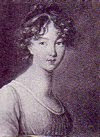
I have knit five of these caps (four are featured here) from Godey’s Lady’s Book and Magazine, April, 1858.

The pattern for “this useful little article” is very easy with alternate five row sections and colours of stocking and garter stitch. I put in an extra row in the beginning for support. Since there are five rows, the new colour cannot be carried up or over the section so I left a long loop behind the knitting each time I changed wool. I cut these in the middle when I finished and the tails became the gathering knot on each side at the end.

The puffy, lacy texture is created by knitting and dropping alternate stitches on the row before the cast/bind off row. The finished row, with fewer stitches, creates a firmer edge although the original pattern suggests that the cast-off row should be done loosely. The next step is to pull, from the middle of the cap outwards on each side, the dropped stitches. It is best to work the middle, then one side, then the other, and then back to the middle, repeating the process down the cap. I did not enjoy this part – it just feels dreadful to be tugging and pulling at the stitches. I would also recommend leaving two to three stitches unpulled on the sides as there is too much puffing out at the gathered section near the ears. The fringe was not much fun to make either but then I don’t like fringes and making them is extremely tedious. Other than that, this cap couldn’t be easier to knit and can be worked up in few hours.

The pattern suggests rosettes at the top of the ribbons although the illustration shows some sort of bow. Perhaps this is a style of mid-19th century rosette? I am not that fond of rosettes so I chose bows for my cap (burgundy/white, no fringe.) All of the other caps have rosettes that are more like small cockades as my skills were limited here. My cap rests around or over the bun of hair at the back.

The pattern required “the smallest size ivory needles” and “single Berlin wool.” These caps were knit on 3.25mm/3 US needles using Knit Picks’s Palette and Shadow Kettle Dyed (my cap.) The gathering on either side brings them up more narrowly than in the illustration. I am planning to make another one, with longer ribbons and a fringe, and not gather it tightly but let it drape more in the back to resemble the one in the original illustration. If anyone can suggest how I can create a shaggier fringe, as in the illustration, please let me know.


















